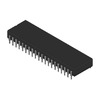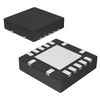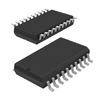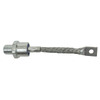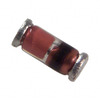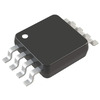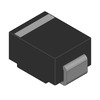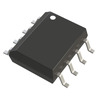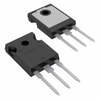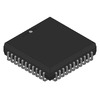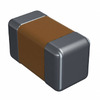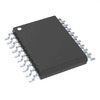Everything You Need to Know About the 2N2219 Transistor
The 2N2219 transistor is an easy-to-use and reliable component widely used in electronic circuits. This article covers everything you need to know about this transistor, from its basic function to its best uses. Whether you're looking to use it for signal amplification or switching tasks, the 2N2219 offers a straightforward solution. We’ll also dive into its features, applications, and how to work with it effectively. Keep reading to understand how the 2N2219 can be a good fit for your projects and what makes it stand out from similar transistors.Catalog

Overview of the 2N2219 Transistor
The 2N2219 transistor is a versatile NPN transistor widely used in electronic circuits. When there is no signal at the base, the transistor remains in an off state, with the collector and emitter disconnected. Once a signal is applied to the base, the transistor switches on, allowing current to flow between the collector and emitter. This switching ability is the foundation of how the transistor works, whether used for amplifying signals or switching circuits on and off. With a gain value (hfe) of 50, the 2N2219 is capable of handling various applications that require both signal amplification and switching control. Its performance is defined by its ability to efficiently control the flow of current, making it a practical choice in many circuit designs.
2N2219 Transistor Pinout

2N2219 CAD Model Overview
2N2219 Symbol

2N2219 Footprint

Technical Specifications of 2N2219
Central Semiconductor 2N2219 technical specifications, attributes, parameters, and parts with similar specifications to Central Semiconductor 2N2219.
| Type | Parameter |
| Factory Lead Time | 8 Weeks |
| Mount | Through Hole |
| Package / Case | TO-39 |
| Collector-Emitter Breakdown Voltage | 30V |
| Number of Elements | 1 |
| Power Dissipation (Max) | 800mW |
| hFE Min | 35 |
| Published | 2012 |
| JESD-609 Code | e0 |
| Pbfree Code | No |
| Part Status | Active |
| Number of Terminations | 3 |
| ECCN Code | EAR99 |
| Terminal Finish | Tin/Lead (Sn/Pb) |
| Max Operating Temperature | 150°C |
| Min Operating Temperature | -65°C |
| HTS Code | 8541.21.00.75 |
| Terminal Position | Bottom |
| Terminal Form | Wire |
| Peak Reflow Temperature (°C) | Not Specified |
| Time @ Peak Reflow Temp (s) | Not Specified |
| Pin Count | 3 |
| JESD-30 Code | O-MBCY-W3 |
| Qualification Status | Not Qualified |
| Polarity | NPN |
| Element Configuration | Single |
| Transistor Application | Switching |
| Gain Bandwidth Product | 250MHz |
| Collector Emitter Voltage (VCEO) | 1.6V |
| Max Collector Current | 800mA |
| Transition Frequency | 250MHz |
| Frequency - Transition | 250MHz |
| Collector Base Voltage (VCBO) | 60V |
| Emitter Base Voltage (VEBO) | 5V |
| DC Current Gain-Min (hFE) | 30 |
| Turn Off Time-Max (toff) | 285ns |
| RoHS Status | RoHS Compliant |
Key Features of 2N2219 Transistor
Small Signal NPN Transistor
The 2N2219 is a small signal NPN transistor, which means it’s designed to handle low-power signals. It switches or amplifies these small signals in various circuits, making it versatile for different tasks in electronics.
Current Gain (hFE) Around 50
The transistor has a typical current gain (hFE) of 50. This gain indicates how much the transistor can amplify the base signal, which is useful when you need to control or boost the current flow in your circuit.
Continuous Collector Current of 800mA
This transistor can handle up to 800mA of continuous collector current. It allows you to manage higher current loads, which makes it a good choice for circuits that require a steady flow of current.
Collector-Emitter Voltage of 50V
The 2N2219 can operate with a collector-emitter voltage of up to 50V. This higher voltage handling capability provides more flexibility for use in circuits with slightly higher voltage requirements.
Collector-Base Voltage of 75V
With a collector-base voltage rating of 75V, the 2N2219 offers a higher margin for circuits that operate with elevated voltages. This feature ensures reliable performance even in circuits with varying voltage levels.
Emitter Base Voltage of 6V
The emitter-base voltage is rated at 6V, indicating the maximum allowable voltage between the emitter and base terminals. This helps protect the transistor from damage in your circuits.
Fast Switching Time
The turn-on time of 40ns and turn-off time of 250ns mean the transistor can switch quickly. This fast response is useful for applications that need rapid on-off cycling, such as in switching circuits.
TO-39 Package
The 2N2219 comes in a TO-39 metal can package, which provides durability and better heat dissipation. This feature helps maintain the transistor’s performance, especially in high-stress environments.
Common Applications of 2N2219 Transistor
Relay Driver
The 2N2219 is often used in circuits that drive relays. It switches the current to control the relay, enabling it to turn larger loads on and off, making it ideal for automation tasks and controlling devices remotely.
LED Driver
This transistor is effective in driving LEDs. It controls the current flowing through the LED, ensuring that it operates safely and efficiently in lighting or display systems, where precise current management is needed.
Audio Amplifiers
In audio amplifier circuits, the 2N2219 can amplify low-level audio signals. It helps boost the signal to drive speakers or headphones, providing clear sound output in various audio systems.
Signal Amplifiers
The 2N2219 works well in signal amplification tasks, such as in communication systems. It amplifies weak signals, improving the strength and clarity of the transmitted or received signals in the circuit.
Darlington Pair
You can pair the 2N2219 with another transistor to form a Darlington pair. This setup allows for greater current amplification, making it useful when a higher gain is required in your circuit applications.
2N2219 Equivalent Transistors
• 2N2905
Best Uses for the 2N2219 Transistor
The 2N2219 transistor can be found in numerous applications, similar to its more common counterpart, the 2N2222. It’s especially useful in situations where slightly higher voltages are involved, thanks to its metal can package that can handle increased stress. Whether you’re building switching circuits or amplifiers, the 2N2219 does a reliable job. In switching circuits, it’s often used to control loads like motors or relays, while in amplification, it helps boost weaker signals. The simplicity of its design and its ability to manage higher voltages makes the 2N2219 a go-to choice for a range of tasks, whether you’re switching loads or amplifying small signals.
Step-by-Step Guide on How to Use the 2N2219 Transistor
The 2N2219 transistor is commonly used as a switch in various circuits. When setting up the transistor, you’ll connect the load to the collector, while the emitter is grounded. This NPN transistor works by controlling the current flow through the base pin. When a small current is applied to the base, it activates the transistor, allowing a larger current to flow from the collector to the emitter, switching on the connected load.

The key part of using the 2N2219 effectively is choosing the correct base resistor, which limits the current going into the base. The value of this resistor is calculated based on the required base current (IB), which is tied to the load’s current demand (IC). The formula to calculate IB is:
IB = IC / hFE
In this case, hFE (the current gain) is around 50. Let's assume your load draws up to 800mA, so the collector current (IC) is 800mA. Based on this, the base current (IB) needed would be 16mA.
Next, you'll need to calculate the base resistor (RB) using this formula:
RB = (VCC - VBE) / IB
Here, VCC is the supply voltage, and VBE is the base-emitter voltage, typically 1.3V for the 2N2219. Using these values, you can determine the right resistor to ensure that the base receives just enough current to turn on the transistor without overloading it.
This process makes the 2N2219 a reliable switch in circuits where controlling higher currents with small base signals is needed. Although the formula provides an estimate, fine-tuning the resistor value through experimentation may sometimes be necessary to get the best performance from the transistor.
2N2219 Transistor Package Details

About the Manufacturer of 2N2219 Transistor
Central Semiconductor has been a trusted name in the semiconductor world since 1974. Known for producing high-quality discrete semiconductors, the company’s products are used in electronic devices all over the globe. Over the years, Central Semiconductor has developed a broad product range, including MOSFETs, rectifiers, silicon carbide devices, and many more. They’ve built a reputation for reliability, consistently delivering components that meet the demands of modern electronics. This long-standing experience ensures that their products, like the 2N2219, continue to be a solid choice for engineers and designers looking for dependable semiconductor solutions.
Frequently Asked Questions [FAQ]
1. Is the 2N2219 similar to the 2N2222?
Yes, the 2N2219 is quite similar to the popular NPN transistor, the 2N2222. However, the main difference lies in the packaging. The 2N2219 comes in a metal can package, which allows it to handle slightly higher voltages compared to the 2N2222.
2. What is the 2N2219 designed for?
The 2N2219 is designed for small signal applications and switching tasks. It is commonly used in circuits where switching and signal amplification are required.
3. How is the 2N2219 packaged?
The 2N2219 comes in a TO-39 metal can package, which provides better heat dissipation and durability in various circuit applications.
About us
ALLELCO LIMITED
Read more
Quick inquiry
Please send an inquiry, we will respond immediately.

Understanding TIP120 Transistor
on October 24th

A Detailed Guide to OPA2134 and TL072 Operational Amplifiers
on October 24th
Popular Posts
-

Understanding Power Supply Voltages in Electronics VCC, VDD, VEE, VSS, and GND
on June 13th 24146
-

USB-C Pinout and Features
on June 13th 21278
-

The Ultimate Guide to Wire Color Codes in Modern Electrical Systems
on January 1th 17459
-

TL494 Current-Mode PWM Controller IC
on January 1th 14726
-

Current Divider Circuits and Effective Use of the Divider Formula
on January 1th 13625
-

FET (Field Effect Transistor) Circuit Symbols
Field-Effect Transistors (FETs) are widely used in modern electronics and are found in everything from simple devices to complex digital systems. To work with these transistors effectively, it's helpful to understand the symbols that represent different types of FETs. These symbols do more than just show what the transistors look like—they also provide information about how each transistor works ...on January 1th 13415
-

Quality (Q) Factor: Equations and Applications
The quality factor, or 'Q', is important when checking how well inductors and resonators work in electronic systems that use radio frequencies (RF). 'Q' measures how well a circuit minimizes energy loss and impacts the range of frequencies the system can handle around its main frequency. In systems with inductors, capacitors, and tuned circuits, a higher 'Q' means the circuit focuses more on a spe...on January 1th 13383
-

Understanding and Building Op-Amp Based Peak Detectors
In the world of electronic circuit design, peak detectors are key tools for accurately analyzing and processing signal strengths. These circuits are designed to find and keep the highest signal amplitude, making sure the peak value is precisely captured and held as needed. Peak detectors are important in many fields, from improving audio quality in communication systems to aiding medical diagnoses...on June 13th 12486
-

LM741 Op-Amp: Features, Specifications, and Applications
The LM741 op-amp is a popular and flexible electronic component. This article goes over the pin layout, functions, specs, and different ways the LM741 can be used, while also comparing it to similar models like the LM358.Catalog1. What Is the LM741 Op-Amp?2. The LM741 Pin Configuration3. The LM741 Pin Functions4. Specifications of the LM7415. Features of LM7416. LM741 Circuit Applications7. LM741 ...on June 13th 12018
-

ST-LINK/V2: Pinout, Specifications, and Datasheet
This article takes you through the ST-LINK/V2, a well-regarded tool that amplifies connectivity and functionality. Key topics will cover its pinout configuration, delve into its 3D model, and spotlight specifications. Such understanding expands the horizons of STM microcontrollers in diverse applications. By grasping these interfaces and tools, you can transform embedded systems, opening doors to ...on January 1th 11570



